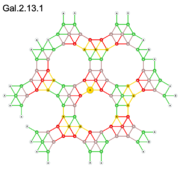OEIS/coors

Generating functions for coordination sequences of uniform tilings
For the 1248 k-uniform tilings determined by Brian Galebach, generating functions (g.f.s) for all corresponding 6536 coordination sequences (coseq.s) were "guessed" by Maple's gfun:guessgf from 128 initial terms. There is a tab-separated file with the result.
As an example we examine the two lines (coseq.s) for Gal.2.13 in this file:
2-Uniform Tiling 13 of 20 Standard notation: [3^6; 3^2.4.12] A301692 Gal.2.13.1 O.g.f.: (-x^13-2*x^12+3*x^10+5*x^9+8*x^8+11*x^7+13*x^6+14*x^5+12*x^4+9*x^3+7*x^2+4*x+1) / (x^10-2*x^5+1) Coefficients: 1,4,7,9,12,14,13,11,8,5,3,0,-2,-1 / 1,0,0,0,0,-2,0,0,0,0,1 a14>s11 Denom. factorized: (x^5-1)^2 A301690 Gal.2.13.2 O.g.f.: (x^10+6*x^9+6*x^8+9*x^7+12*x^6+16*x^5+12*x^4+9*x^3+6*x^2+6*x+1) / (x^10-2*x^5+1) Coefficients: 1,6,6,9,12,16,12,9,6,6,1 / 1,0,0,0,0,-2,0,0,0,0,1 s11=s11 Denom. factorized: (x^5-1)^2
The resulting rational g.f.s (with a numerator and a denominator polynomial) have several obvious properties:
- The coefficient lists for the denominators are always, those for the numerators are often symmetrical (the first half is mirrored, maybe around a center term). This is indicated by "s", or "a" for asymmetrical.
- All coefficient lists start and end with coefficent 1.
- If both the numerator and the denominator coefficient lists are symmetrical, the degrees are both odd (the leading numbers give the occurrences).
Factors of the denominator polynomials
For the denominators of the g.f.s several factorization mathods (Mathematica FactorList and Simplify, Maple factor) were tried with different results. In the end, a Maple procedure of Robert Israel was used:
myfactor:= proc(p) local X, k, P, T, q;
P:= p; T:= 1;
X:= indets(p)[1];
k:= degree(P,X);
while k > 0 do
if rem(P, X^k-1, X, 'q') = 0 then
P:= q; T:= T*(X^k-1)
else
k:= k-1
fi
od;
T * factor(P)
end proc;
With this factorization, the denominators show the following 55 different factors (with number of occurrences prefixed):
892 x+1
2091 x-1
1613 x^2+1
946 x^2+x+1
233 x^2-1
1188 x^2-x+1
981 x^3-1
975 x^4+1
621 x^4+x^3+x^2+x+1
205 x^4-1
884 x^4-x^2+1
783 x^4-x^3+x^2-x+1
1260 x^5-1
445 x^6+x^3+1
205 x^6+x^5+x^4+x^3+x^2+x+1
360 x^6-1
57 x^6-x^3+1
122 x^6-x^5+x^4-x^3+x^2-x+1
1255 x^7-1
130 x^8+1
468 x^8-1
20 x^8-x^4+1
38 x^8-x^6+x^4-x^2+1
124 x^8-x^7+x^5-x^4+x^3-x+1
1144 x^9-1
145 x^10+x^9+x^8+x^7+x^6+x^5+x^4+x^3+x^2+x+1
628 x^10-1
6 x^10-x^9+x^8-x^7+x^6-x^5+x^4-x^3+x^2-x+1
1492 x^11-1
6 x^12+x^11-x^9-x^8+x^6-x^4-x^3+x+1
182 x^12-1
2 x^12-x^10+x^8-x^6+x^4-x^2+1
5 x^12-x^11+x^10-x^9+x^8-x^7+x^6-x^5+x^4-x^3+x^2-x+1
12 x^12-x^11+x^9-x^8+x^6-x^4+x^3-x+1
5 x^12-x^6+1
452 x^13-1
117 x^14-1
198 x^15-1
6 x^16+1
29 x^16-1
89 x^17-1
6 x^18+x^9+1
57 x^18-1
59 x^19-1
10 x^20-1
20 x^21-1
6 x^23-1
3 x^24-1
18 x^25-1
6 x^27-1
32 x^28-1
6 x^30-1
6 x^35-1
6 x^36-1
6 x^40-1
- Most of the factors have the form x^k-1.
- There are no coefficients > 1.
- Some of the polynomials could be further reduced by a substitutions x^m -> y .
- After such substitutions, the factors have the form sum(k=0..n: (+-1)^k * x^k), except for one polynomials of degree 8 and two polynomials of degree 12.